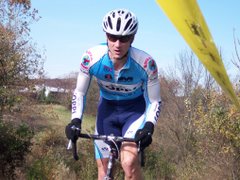
Training the Brain
I’ve been following a fascinating series of posts on the Science of Sport blog regarding the question of “mind vs. matter” – specifically, whether physiology or psychology is the key difference between good and great athletes.
The basic point made by the authors is that “the brain is ultimately in control of exercise, and that fatigue, or the decision to slow down during exercise is not taken because the muscles are failing, but rather because the brain is regulating the degree of muscle activation so that we are protected from physiological harm.”
This should not be oversimplified to mean that you can “will” yourself to a better performance than you can manage physiologically. Instead, it means the opposite: that your mind can hinder you from performing up to your physiological potential.
The key to putting this hypothesis to work is by training both the brain and body simultaneously, or “Brain Training,” as Matt Fitzgerald puts it.
I’ll excerpt a key section of the blog here:
Linking in training - mental and psychological factors are forged in training
And then very importantly, perhaps most crucially of all, is that your mental approach to racing, your confidence, your belief, are not simply mental tricks. This is not about just hypnotizing yourself into running faster, into suffering a little more. It's an approach to training. Once again, in the words of Jamie from yesterday's post: "Training responses are initiated, determined, and dictated by the brain. Without attention to the control of thought processes...or attention to the encoding of exact movement patterns, many athletes will be trained inappropriately." So the point is, training is an act of physiology, but it's also an act of psychology, and it's in training that the thought patterns, the elusive concept of mental strength, the belief and the ability to regulate pace, are laid down. So let me end with another bit of information about Bannister and Landy. Roger Bannister would go on to become a decorated neuroscientist - he was studying medicine when he ran his 4-minute mile, and specialized in understanding the very organ that may have provided his edge - the brain. Part of his training included a session of 10 x 400 m repeats, run at race pace (59 seconds), with a 1:30 recovery. He was preparing his brain, and his body, and his mind (for the brain is not simply a mind - it's an organ of physiology!), for the effort it would take. Of course, I can't account for Landy's training, but Bannister's career focused on understanding the physiology of the brain. I dare say he did the same in his training. The result? 3:59.4, and a place in history.
The “burst” workouts that I’ve been doing recently are a great example of “brain” training. They involve steady-state riding at tempo wattage (just below threshold) with frequent “bursts” to power at or above threshold, followed immediately by recovery to the previous wattage. Physiologically, this trains you the same way that riding at threshold would. Psychologically, however, it trains you to go hard without blowing up and convinces you that you can recover from a hard effort while still maintaining a strong pace. These workouts are very race-specific, because they mimic the types of efforts that you must use to go with surges during races. If you keep doing these workouts, eventually you’ll be able to maintain a higher base wattage AND go harder during each burst. Best of all, they will begin to SEEM easier – which is the sign that you have successfully trained your brain and your body.



